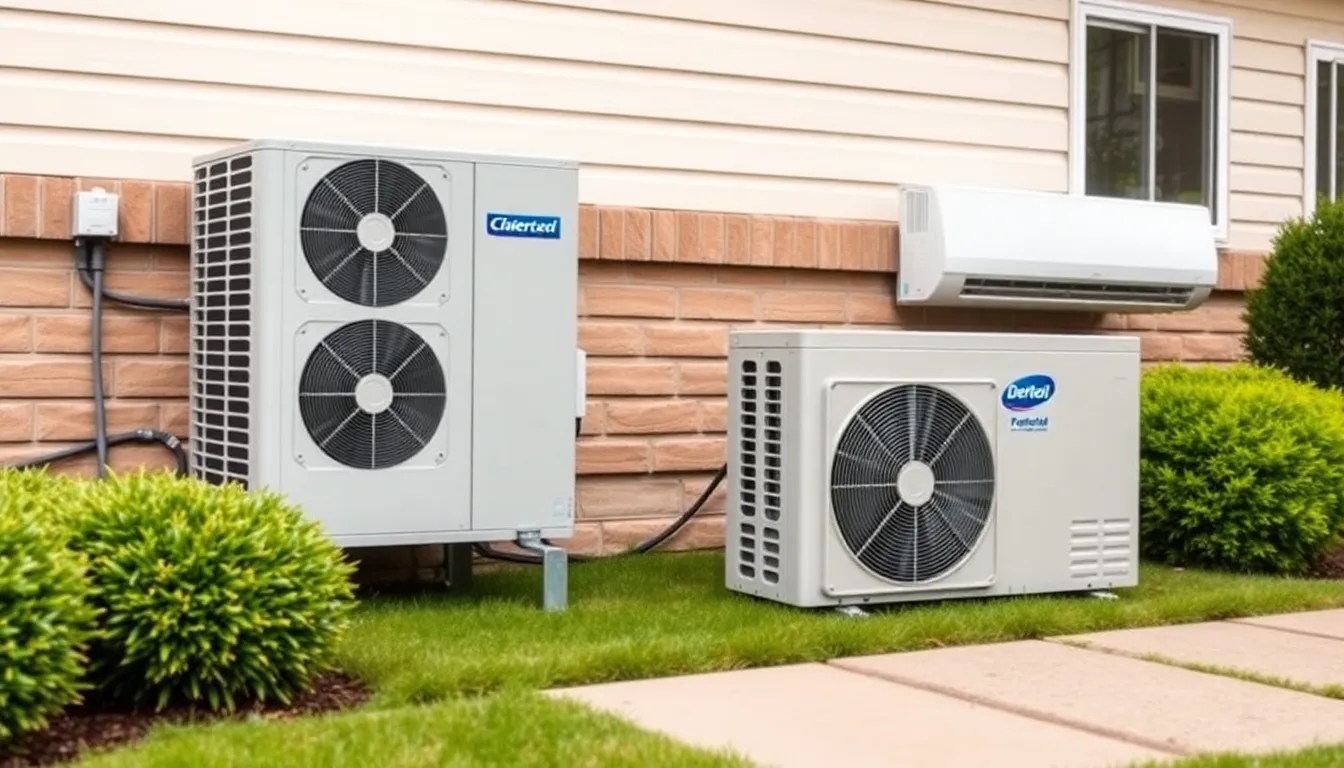When the summer heat sets in, many people rely on their air conditioning systems to keep their homes cool and comfortable. But have you ever wondered what the outside component of your AC unit is actually called? This essential piece of equipment plays a crucial role in the cooling process, but it often goes unnoticed.
Known as the condenser unit or outdoor unit, this component is responsible for releasing heat absorbed from inside the home. Understanding its function can help homeowners appreciate the importance of regular maintenance and care. In this article, we’ll explore the various names and functions of this vital piece of HVAC equipment, shedding light on its role in keeping indoor spaces refreshingly cool.
Table of Contents
ToggleWhat Is the Outside AC Unit Called?
The outside AC unit is primarily referred to as the condenser unit. This component is vital in air conditioning systems, as it expels heat absorbed from the interior. It typically consists of a compressor, coils, a fan, and other elements that facilitate this process.
Homeowners may also encounter alternative terms for the condenser unit, including outdoor unit and outside condensing unit. Each term serves to describe the same essential piece of equipment that helps maintain indoor comfort by regulating temperature.
Regular maintenance of the condenser unit extends its lifespan and ensures effective performance. Homeowners must keep the outdoor unit free from debris, dirt, and vegetation. Ignoring the upkeep can lead to decreased efficiency and possible damage to the overall air conditioning system.
Understanding the functions and terminology associated with the outside AC unit strengthens homeowners’ knowledge when dealing with HVAC systems, ultimately leading to better maintenance practices.
Types of Outside AC Units

Different types of outside AC units serve various cooling needs and preferences. Homeowners can choose from central air conditioning units or ductless mini-split systems, each with unique characteristics.
Central Air Conditioning Units
Central air conditioning units feature a condenser unit located outside the home, connected to ductwork that distributes cool air indoors. Components include a compressor, coils, and a fan, working together for efficient temperature regulation. These systems excel in cooling large spaces and are ideal for homes with existing duct systems. Regular maintenance ensures optimal performance and longevity, preventing breakdowns during peak usage.
Ductless Mini-Split Systems
Ductless mini-split systems consist of an exterior condenser unit and one or more indoor air handlers. This setup eliminates the need for ductwork, making it suitable for homes without pre-existing ducts. Each indoor unit operates independently, allowing for customizable temperature control in different rooms. Energy efficiency is a notable feature, as these systems often use inverter technology to adjust compressor speed according to demand. Routine maintenance guarantees effective operation and prolongs the life of the system.
Components of an Outside AC Unit
The outdoor AC unit consists of several key components that work together to ensure efficient cooling. Understanding these components helps homeowners maintain their air conditioning systems effectively.
Compressor
The compressor serves as the heart of the outside AC unit. It compresses refrigerant gas, raising its temperature and pressure before it moves to the condenser. The compressor’s operation allows for the cooling process to begin, as the refrigerant will later release heat outside. Regular checks of the compressor’s functionality can prevent issues that minimize cooling efficiency.
Condenser Coil
The condenser coil’s primary role is to release heat absorbed from inside the home. As the high-pressure refrigerant gas flows through the coil, it dissipates heat into the outdoor air, cooling down and transforming into a liquid. Maintaining clean condenser coils ensures optimal heat exchange; dirty coils can impede performance and increase energy consumption.
Evaporator Coil
The evaporator coil is located inside the home, but its relationship with the outdoor AC unit is critical. It absorbs heat from indoor air as the refrigerant evaporates, ensuring cool air circulation within the living space. While not part of the outside unit, its efficiency depends on the performance of the outdoor components. Regular cleaning and maintenance of the evaporator coil help maintain the entire system’s efficiency.
Functionality of Outside AC Units
Outside AC units, primarily referred to as condenser units, play a critical role in the air conditioning process. These systems function by expelling heat absorbed from inside the home to the outdoor environment, enabling efficient cooling throughout the living space.
Key Functions of Outside AC Units
- Heat Exchange: Outside AC units facilitate heat exchange by compressing refrigerant gas in the compressor, initiating the cooling cycle. This process allows heat transfer from indoors to the outside atmosphere.
- Cooling Process: The condenser coil is essential for releasing the heat collected from the indoor air. As warm refrigerant passes through the coil, it dissipates heat, cooling down before returning indoors as a chilled vapor.
- Air Circulation: A fan within the outside unit enhances air circulation. It draws outdoor air across the condenser coil, optimizing heat dissipation while assisting in the refrigerant cooling process.
Importance of Maintenance
Regular maintenance of outside AC units ensures they function effectively. Dirty coils and blocked fans can significantly impair heat exchange, leading to reduced efficiency. Cleaning coils and checking refrigerant levels contribute to the longevity and performance of the entire air conditioning system.
Types of Outside AC Units
- Central Air Conditioning Units: These units utilize a single outdoor condenser connected to ductwork. They efficiently cool large areas, making them suitable for expansive homes or commercial spaces.
- Ductless Mini-Split Systems: These systems consist of an exterior condenser paired with multiple indoor air handlers. They offer flexibility in cooling different zones independently, eliminating the need for ductwork.
Understanding the functionality of outside AC units empowers homeowners to engage in informed maintenance practices, ensuring optimal performance and energy efficiency.
Importance of Maintenance
Regular maintenance of the outdoor AC unit is vital for optimal performance and longevity. Clean components prevent inefficiency; dirt and debris can block airflow, leading to overheating and potential system failure. Homeowners should conduct routine checks and cleanings, ensuring the condenser coils remain free from buildup.
Checking refrigerant levels also plays a role in maintenance. Low refrigerant causes the system to work harder, increasing energy consumption and leading to potential damage. Monitoring and correcting refrigerant levels keeps the unit operating efficiently.
Evaluating the unit’s fan operation is crucial. A malfunctioning fan can hinder airflow, reducing the system’s ability to release heat effectively. Homeowners should listen for unusual noises and address any irregularities promptly, preventing more significant issues from developing.
Inspecting electrical connections and components is another essential maintenance task. Loose connections can lead to electrical failures or system shutdowns. Regularly tightening connections and ensuring proper functionality enhances overall safety.
Scheduling professional maintenance at least once a year is strongly advised. Technicians can identify potential problems before they escalate, performing comprehensive inspections and servicing. Their expertise ensures that all components work harmoniously, ultimately maximizing energy efficiency and comfort within the home.
Understanding the outdoor AC unit is essential for homeowners looking to maintain a comfortable indoor environment. This vital component plays a significant role in the overall efficiency of air conditioning systems. Regular maintenance not only extends its lifespan but also ensures optimal performance during the hot summer months.
By recognizing the different types of outside AC units and their components, homeowners can make informed decisions about their cooling needs. Engaging in routine checks and scheduling professional maintenance can prevent costly breakdowns and enhance energy efficiency. Prioritizing the care of the condenser unit ultimately leads to a more reliable and effective cooling system.


